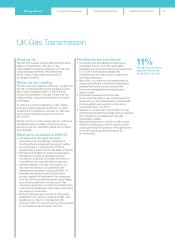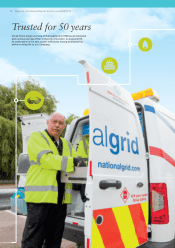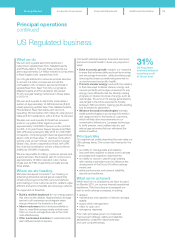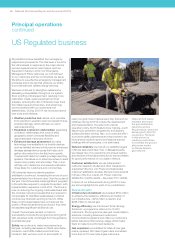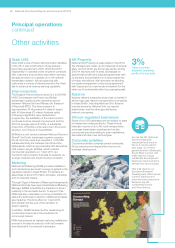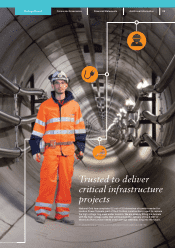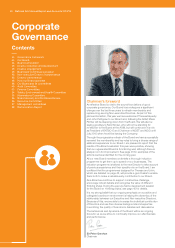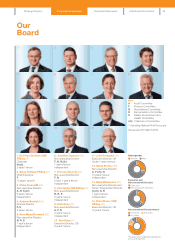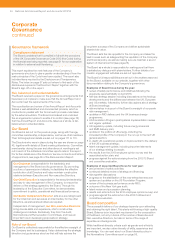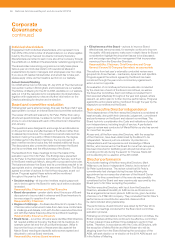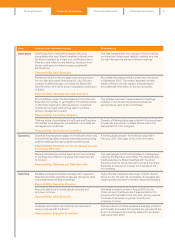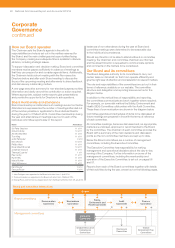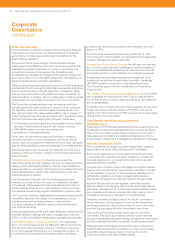National Grid 2014 Annual Report Download - page 42
Download and view the complete annual report
Please find page 42 of the 2014 National Grid annual report below. You can navigate through the pages in the report by either clicking on the pages listed below, or by using the keyword search tool below to find specific information within the annual report.
People If we are to achieve our strategic goals,
we need to make sure our employees
havetheright skills and capabilities.
During 2013/14 we have focused particularly on the
areas that we believe can generate the most value
for the Company through our people – both now
and in the future.
This has involved a focus on future leaders,
operational leaders, engineers and stakeholder
relationship managers. In addition to increasing our
capability across these groups we also need to
make sure we have enough people in each group.
We will also be developing plans to improve our
succession planning for our operational leader,
engineer and stakeholder relationship manager roles.
Building skills andexpertise
As we continue working under RIIO in the UK
andbecome increasingly focused on driving
performance on both sides of the Atlantic, we have
identified three main business capabilities we need
to develop among our workforce to support us in
achieving our strategic objectives: performance
excellence; customer and stakeholder management;
and contract management.
We believe that by focusing on these capabilities
wewill make sure we meet our customers’ and
stakeholders’ expectations while building a
systematic approach to improving performance.
To help us do this, we have brought all our learning
and development resources together under
ourAcademy.
To date, 110 of our senior leaders in the UK have
attended our performance excellence senior
leadership programme through our Academy
andsimilar programmes have started in the US.
Attracting the best people
We are involved in a number of initiatives to help
attract new talent into our organisation and industry.
In the UK, these include:
• working with the energy sector towards delivering
11,000 new apprenticeships and traineeships over
the next three years through the Energy &
Efficiency Industrial Partnership;
• developing our own people through Advanced
Apprenticeships and engineer training;
• supporting power systems undergraduate
bursaries through the Power Academy; and
• making sure our graduates continue their
development throughout their career with us.
Initiatives in the US include:
• energy utility technology certificate programmes
– partnerships with seven local community
colleges to develop and prepare students to
become future electric line workers;
• ‘Troops to Energy Jobs’ – a programme designed
to help veterans determine how their military skills
and experience translate into the skills we are
looking for;
• real work experience and leadership training
forqualified graduates in engineering and
business disciplines; and
• summer internships – providing six to eight week
opportunities for college students to gain work
experience with us.
Safeguarding the future
In the UK, around 89,000 people are needed
annually to meet demand in the UK’s engineering
sector over the next decade, yet only around
51,000are joining the profession each year.
To address this shortage, we are running or are
involved with a number of programmes and
initiatives aimed at encouraging young people
tostudy STEM subjects. These include:
• ‘School Power’, which provides classroom
resources, including a dedicated website,
tosupport the teaching of STEM subjects;
• work experience, offering year 10 students
aweek-long residential course at our Eakring
Academy (totalling 100 each year); and
• open house visits to our sites to give students
andteachers an insight into gas and electricity
systems, as well as future energy challenges.
We are leading a consortium of businesses to create
an exhibition called ‘That Could Be Me’ at the
Science Museum in London, which will provide
insight into engineering as a career. It is due to
launch in December 2014.
A further initiative, called ‘Careers Lab’, aims to
helpestablish a coordinated approach towards
businesses taking responsibility for the skills
agenda. The pilot scheme, which began in January
2014, involves businesses and schools in the
Midlands working together to progress careers
advice programmes for young people.
In the US, overall engineering employment is
expected to grow by 11% through to 2018, varying
by specialty. By 2018, STEM occupations will
account for about 1.1 million new jobs and 1.3 million
replacement positions due to STEM workers leaving
the workforce.
We are working with high schools and community
colleges to build a curriculum that meets future
workforce needs – and supporting STEM education
at K-12 levels. An example of this is the National Grid
Engineering Pipeline Program – a six year
developmental journey designed to inspire young
people to pursue an education and career in
engineering. To date 164 young people have
enteredinto the programme.
We also work closely with the National Centre
forEnergy Workforce Development on its
‘energyindustry fundamentals’ curriculum
andcompetency models.
40 National Grid Annual Report and Accounts 2013/14



